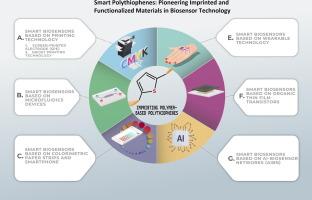Smart Polythiophenes: Pioneering imprinted and functionalized materials in biosensor technology
IF 4.9
2区 化学
Q1 CHEMISTRY, ANALYTICAL
引用次数: 0
Abstract
Smart designs beyond the limitations of the biosensors present fascinating opportunities for portable, flexible, versatile, and effective performance that allow for the rapid in-vivo, and real-time detection of potential targets. Conjugated polythiophenes (CPTs) are particularly valuable as biosensors because of their remarkable brightness, excellent photostability, and low toxicity. CPTs potentially molecularly self-assemble using an imprinted method resulting in imprinted conjugated polythiophenes (ICPTs). ICPTs combined the distinctive characteristics of CPTs with the excellent selectivity arising from robustly particular binding sites of molecular imprinting. ICPT-based biomimetic sensors represent a specialized subset within this extensive field. An overview of various types of CPT-based sensors was described to achieve a systematic analysis. These included biosensors based on printing technologies, microfluidic systems, film transistors, colorimetric methods, and electrochemical approaches. Additionally, we discussed the optical-electrical properties, and sub-types of polythiophene derivatives examining their specific applications and advantages in biosensor technology. The final section provided an in-depth exploration of the imprinted techniques employed in developing ICPTs-based sensors, with particular emphasis on applications in biochemical sensing.

智能聚噻吩:开拓生物传感器技术中的压印和功能化材料
超越生物传感器局限性的智能设计为实现便携、灵活、多用途和高效的性能提供了令人着迷的机会,从而能够对潜在目标进行快速体内实时检测。共轭聚噻吩(CPTs)具有显著的亮度、出色的光稳定性和低毒性,因此作为生物传感器尤为重要。利用压印法,CPT 可以进行分子自组装,从而形成压印共轭聚噻吩(ICPT)。ICPT 将 CPT 的独特特性与分子印迹的特定结合位点所产生的出色选择性结合在一起。基于 ICPT 的仿生物传感器是这一广泛领域中的一个专门子集。本文概述了各种类型的 CPT 传感器,以便进行系统分析。其中包括基于印刷技术、微流控系统、薄膜晶体管、比色法和电化学方法的生物传感器。此外,我们还讨论了聚噻吩衍生物的光电特性和子类型,研究了它们在生物传感器技术中的具体应用和优势。最后一节深入探讨了在开发基于 ICPTs 的传感器时所采用的压印技术,并特别强调了在生化传感中的应用。
本文章由计算机程序翻译,如有差异,请以英文原文为准。
求助全文
约1分钟内获得全文
求助全文
来源期刊

Microchemical Journal
化学-分析化学
CiteScore
8.70
自引率
8.30%
发文量
1131
审稿时长
1.9 months
期刊介绍:
The Microchemical Journal is a peer reviewed journal devoted to all aspects and phases of analytical chemistry and chemical analysis. The Microchemical Journal publishes articles which are at the forefront of modern analytical chemistry and cover innovations in the techniques to the finest possible limits. This includes fundamental aspects, instrumentation, new developments, innovative and novel methods and applications including environmental and clinical field.
Traditional classical analytical methods such as spectrophotometry and titrimetry as well as established instrumentation methods such as flame and graphite furnace atomic absorption spectrometry, gas chromatography, and modified glassy or carbon electrode electrochemical methods will be considered, provided they show significant improvements and novelty compared to the established methods.
 求助内容:
求助内容: 应助结果提醒方式:
应助结果提醒方式:


